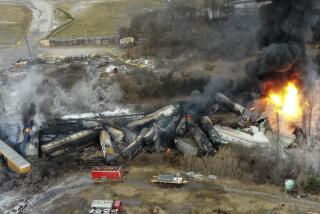Concerns About Rail Merger
- Share via
The huge railroad mergers of the 1990s have yet to produce the low prices and better service that they promised. So when Burlington Northern and Canadian National announced a merger last Monday, U.S. and Canadian shippers were understandably upset. The deal might be inevitable, but in reviewing it the government should make sure the shipping community will be well served.
Since 1980, when Congress partly deregulated the rail industry, mergers and bankruptcies have reduced the number of big railroads from 30 to seven. Since the mid-1990s, Union Pacific merged with Chicago & North Western, and Southern Pacific and Conrail were split up between CSX and Norfolk Southern. Burlington merged with Santa Fe, and Canadian National gobbled up Illinois Central.
The premise of these mergers was that economies they would generate would reduce costs to shippers and that railroads serving large areas would be able to provide “seamless,” faster and more reliable service, while the bigger railroads would be able to compete against the increasingly dominant truckers. Much of that hasn’t developed. In fact, Southern California shippers are still smarting from a rail crisis that the merger of Union Pacific and Southern Pacific precipitated.
Frank Wilner, a railroad expert and author of a book on rail mergers, believes shippers’ worries about the Burlington Northern-Canadian National union are fully justified. Captive shippers--mainly coal mines and grain shippers that depend on rail transport--have seen their rates decline but costs rise as they are being required to invest in rolling stock and loading facilities. Instead of seamless service, railroads are providing freight transport so slow and erratic that many shippers are simply giving up on them. Consequently, although rails once controlled more than a third of freight transport, their share of the market today has dwindled to about 11%.
Railroad stockholders too have rarely seen the benefits of rail mergers. Earnings of the merged railroads have been consistently disappointing. “In none of the cases,” Wilner found, “have the economic promises of rail mergers been fulfilled.”
Still, this is not to say the BN-CN union is bound to fail. Paul Tellier, CN’s chief executive, who would run the new railroad as well, is a formidable business executive. Since CN’s privatization in 1995, he turned the bankrupt railroad into a profitable, efficient carrier. The merger itself would create a 50,000-mile rail network connecting Los Angeles and Long Beach ports with points up to the western Canadian city of Vancouver and across the continent to Halifax.
But as the top U.S. rail regulator, Linda Morgan, points out, “railroads, together with their customers and employees, have not yet fully adjusted to recent mergers” and the railroad business might not be ready for yet another wave of mergers. The railroads should be aware that the burden of proving a rail merger will work is getting heavier every time a previous one fails to deliver.
More to Read
Sign up for Essential California
The most important California stories and recommendations in your inbox every morning.
You may occasionally receive promotional content from the Los Angeles Times.













